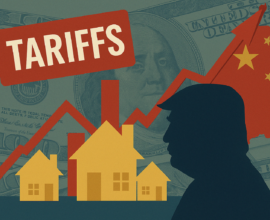How to Find Great REITs for Your Portfolio
REITs provide the gift of cash flow with far less work than owning real estate. These assets function like dividend stocks that give you exposure to real estate. You can invest in cash flow–producing companies and get a portion of their profits.
Just like a stock, a REIT can also appreciate rapidly. There’s more to this investment than the cash flow. Investors can use different criteria to determine which REITs make the most sense for their portfolios. They can pick riskier REITs for higher potential returns or less risky REITs for more reliable returns.
Investors can also shortlist their search for specific sectors. Some investors only want industrial REITs, while others prefer data centers.
We all want the same thing from our REITs. We want consistent, growing cash flow and appreciation. We can get both of those things as REIT investors. We’ll first go over how to identify a great REIT. That way you’ll know which ones make the most sense for your portfolio.
REIT Metrics to Consider
A data-driven approach leads to high confidence investing. When you’re confident in an asset, it’s easier to hold onto it during market corrections. REIT investors can consider many metrics when making their investing decisions.
Reviewing these metrics will help you realize if a REIT makes sense for your portfolio or not. Think of it as learning how to catch a fish instead of taking someone else’s advice without much thought.
Dividend History
The best part about REITs is the growing dividend. Great REITs raise their dividend each year. Even if the dividend only rises by a few cents, it’s more than what you made last year.
Dividend hikes also help you keep up with inflation. Our historic inflation makes that more difficult this year, but REIT dividend hikes normally outpace inflation. Some will still outpace inflation even in this economy.
Revenue and Earnings Growth
A growing company translates into a rising market cap. REITs publicize their top-line and bottom-line growth every quarter. Yahoo! Finance lets you look at the past four years of earnings and revenue growth for any REIT. The site also lets investors see breakdowns for the four most recent quarters.
Past results don’t guarantee future success. However, a proven track record certainly helps. Struggling REITs often remain stagnant. High-growth REITs usually continue on that trajectory.
Dividend Sustainability
Dividends don’t appear out of thin air. They come from a portion of a REIT’s earnings. Some REIT investors get tricked by high-yielding REITs. Some of these REITs can continue producing high cash flow. However, other high-yield REITs will soon have to slash their dividends to survive. Not every REIT has a sustainable dividend.
For most stocks, you can compare the quarterly dividend with the quarterly EPS. A stock reporting $1 EPS and paying a $0.90 quarterly dividend has little room for error. This high dividend also hurts reinvestments. The company can only reinvest $0.10 per share instead of $1 per share.
Luckily, we use a different metric for REITs, known as funds from operations (FFO). This metric gives us a more accurate understanding of a REIT’s sustainability. Depreciation shows up as an expense that reduces a REIT’s net income. Even though depreciation is an arbitrary number that doesn’t go out of the REIT’s pocket, it still lowers EPS.
FFO adds depreciation to net income while subtracting capital gains from property sales. An FFO per share of $1.50 makes a $1 quarterly dividend payment more sustainable. In theory, if a REIT can grow FFO by 10% each year, that REIT can also raise its dividend by 10% each year.
All REITs list their FFO in their footnotes. You can also find a stock’s FFO with a quick Google search. If you want to find the FFO for Realty Income, you can search “Realty Income Stock FFO” on Google. You can perform a similar search to access a REIT’s dividend history.
FFO and Dividends Real Life Scenario
We’ll use Stag Industrial to demonstrate how FFO indicates dividend sustainability. Stag specializes in single-tenant industrial properties and has a portfolio across the U.S. Stag generated $2.09 FFO per share in 2021.
Stag Industrial pays a monthly dividend that they raise once per year. In 2021, the company paid a monthly dividend of $0.121 per share, totaling $1.452 per share for the entire year.
The gap between annual FFO per share and dividend payout per share is $0.638. This gap explains why the company comfortably raised its monthly payout from $0.121/share to $0.122/share. The company can put the rest of the funds towards expansive investments while rewarding shareholders with a 3.7% dividend yield at current prices.
Shareholders realize the full value from growth either way. Lower dividend payouts lead to higher stock price appreciation. REITs like Stag Industrial have large margins of safety between their FFO and dividend payouts.
Not every REIT properly stands the test of time. Macerich is a REIT that invests in shopping centers. The company got hurt during the pandemic, but there were several warnings signs before the pandemic hurt shopping centers.
In November 2019, the company missed its annual dividend hike. The company paid its dividend to keep shareholders happy, but they didn’t commit to raising the dividend payout per share. Shareholders view dividend raises as signs of confidence from management. A failure to raise the dividend is fair reason for concern.
At one point, the company paid an annual dividend of $3/share spread evenly across four quarterly payouts. In 2021, the company produced FFO per share of $1.66, which isn’t enough to support the annual $3 dividend payout per share.
The company adjusted during the pandemic and currently pays an annualized dividend of $0.60/share, a far cry from the pre-pandemic level. Failure to raise the dividend suggests sustainability issues. Some companies raise debt to pay dividends just to keep shareholders happy, but that catches up to them eventually.
Unlike Stag Industrial, Macerich has been a losing investment, as it’s been down over 75% in the past five years. The more reliable Stag Industrial has jumped over 60% within the same timeframe.
Valuation
Have you heard the phrase, “Great company, bad stock”? People use this phrase to describe healthy but overvalued companies.
A company may double annual revenue from $1 million to $2 million and expand its profit margin. Both developments indicate a healthy, growing company. However, it wouldn’t make sense to enter a position in this company if it had a $10 billion valuation.
REITs don’t have disparities that dramatic. You’ll find that mismatch in bubbly stocks. Investors should still look at valuations to gauge REITs. Some investors use the price-to-FFO ratio. A REIT trading at $10/share with an annualized $2 FFO per share has a price-to-FFO ratio of five. Yahoo! Finance provides quicker access to the P/E and P/S ratios.
Investors can compare REIT valuations to see which asset provides the best value. Y-Charts provides charts that track any publicly traded REIT’s historical valuations. The chart can show you a REIT’s P/S, P/E, or other multiples across five years. A declining valuation combined with upbeat revenue and earnings can indicate a buying opportunity.
Where to Find Great REITs
We have discussed several strategies to value REITs and define your criteria. You can add other metrics to your list as you learn more about the industry and your objectives.
Knowing your criteria won’t help if you don’t know where to find REITs. You might stumble across a REIT via word of mouth, but we can do better than that. Use this process to quickly discover numerous REIT opportunities.
Start with REIT ETFs
REIT ETFs give you exposure to several REITs. These funds are a cheat code for portfolio diversification. You could invest in these funds and have someone else do the research. You’ll then have to research the funds and aim for an attractive yield.
Even if you want to find your own REITs, these ETFs can help. All ETFs must disclose their positions and concentrations. You can review any ETF’s top holdings and analyze those REITs.
VNQ is a popular REIT ETF in the investing space. The company holds onto over 160 REITs and boasts a $28 billion market cap. A closer look at VNQ’s positions reveals a Vanguard real estate index fund, Prologis, and American Tower as the top three holdings. You can see the other seven holdings in order on their page. The fund has heavy concentrations in specialized, residential, industrial, and retail REITs.
You may not like commercial REITs for your portfolio. In this case, you can avoid the commercial REITs in VNQ and focus on the other opportunities. Some investors prefer to cherry-pick a fund’s picks than find REITs on their own. Some REIT investors look at VNQ’s Top 10 list and buy some of those REITs instead of the fund.
You can repeat this process for any REIT ETF. Some investors look for similarities before adding REITs to their portfolios.
Use a Stock Screener
Stock screeners let you filter stocks based on your desired parameters, such as sector, market cap, revenue growth, valuation metrics, and other inputs.
You can filter a stock screener so it only shows REITs. If you want tech companies like the FAANG stocks, you can use that parameter for your next search. Stock screeners eliminate many stocks and provide a shortlist that fits your criteria.
Most brokers offer a stock screener for their customers. You can also use Yahoo! Finance free stock screener to find great REITs.
Join Online Investing Groups
Hanging out with investors provides many benefits. You’ll surround yourself with like-minded people who want to grow their money. Even if you don’t learn anything new from these groups, improving your inner circle will pay great dividends.
Some groups provide quality due diligence and offer great suggestions. You shouldn’t make an investment decision based on what one person says. However, you can use groups like the REIT Investing Community to find new investing ideas and come across fairly valued REITs.
Some members ask questions and learn new insights quickly. Don’t be afraid to ask a question if you want clarification. Everyone starts out as a beginner. You can find free investing groups on Facebook, LinkedIn, and other social networks. Surrounding yourself with investors will turn you into a better investor.
Learn REIT Investing as You Go
Building up your education leaves you more prepared. Creating criteria and shortlisting REITs can increase your confidence. However, the best way to learn about REITs is through investments.
REITs are highly liquid and require very little capital to initiate positions. You could buy fractional shares of REITs to test the waters. Theoretically, you could invest in REITs with as little as $1.
Investors grow their wealth with consistent investments. As you invest in REITs more often, your cash flow and possibilities will grow.








